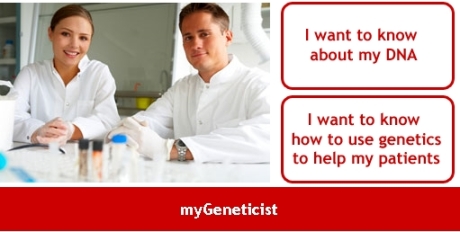The DNA Network |
| Posted: 29 Nov 2008 08:23 PM CST  Image by sean dreilinger via Flickr I was irked to see, in today’s New York Times, a picture of a young child having his cheek swabbed so that his parents could ascertain his status at the rs1815739 C/T variant . T-alleles at this site give rise to a premature stop codon in the alpha 3 actinin (ACTN3) gene while the C-allele encodes a full-length version that contributes to the fast twitching of muscle fibers. Not surprisingly, it was found [PubMed Central ID: PMC118068] that folks who have achieved status as Olympic caliber sprinters are more likely to carry the C-allele than ethnically matched controls. The company, Atlas Sports Genetics is now marketing the test, for $149 as a means to “predict a child's natural athletic strengths”. Holy Crap ! Its sad to think of the myriad of ways in which genetic information can be misused and misrepresented - sadder still to think of using genetic tests to deny kids the simple joy of playing with each other. Parents may be intersted to know that among europeans and asians, the C-allele is present at about 50%, making about 75% of the population either a C/C or a C/T … which, taken alone, explains very little of why a handful of individuals achieve athletic success. Parents considering paying the $149 might also wish to read a recent article by Dr. Jerome Kagan, a well-regarded developmental psychologist on recent trends in overparenting. My 23andMe profile shows a middling C/T which is on par with my middling soccer skills. Nevertheless, I had a great experience learning and building relationships with my pals on the soccer field, many who remain friends even still.  | |||||||||||||||||||||||||||||||||||||||||||||
| Cyberchondria and Health 2.0 News [ScienceRoll] Posted: 29 Nov 2008 02:51 PM CST I should study psychiatry for my next exam, but I must share a few articles with you first:
 | |||||||||||||||||||||||||||||||||||||||||||||
| MyGeneticist: I want to know about my DNA [ScienceRoll] Posted: 29 Nov 2008 02:30 PM CST Steve Murphy, our gene sherpa, informed us about a new site, MyGeneticist.com which
We need such services… I can’t wait to see how it actually works.  | |||||||||||||||||||||||||||||||||||||||||||||
| Genome Island in Second Life [ScienceRoll] Posted: 29 Nov 2008 02:12 PM CST Do you remember my post mentioning Genome Island, a unique educational place in Second Life? I also made an interview with Max Chatnoir, the creator. Now you can explore the island through a video: Further reading:
 | |||||||||||||||||||||||||||||||||||||||||||||
| Dangerous chemistry: explosive experiments with junk food [Discovering Biology in a Digital World] Posted: 29 Nov 2008 01:21 PM CST It's a long, long, weekend; perfect for going outside and doing a few loud, messy experiments. Cooking-intensive holidays always remind me how much fun it is to do a bit of chemistry, especially when it comes to food. If you watched the video that I posted on Thanksgiving, you've probably been itching to try one of these experiments yourself. Read the rest of this post... | Read the comments on this post... | |||||||||||||||||||||||||||||||||||||||||||||
| Parliamentary politics. [Genomicron] Posted: 29 Nov 2008 08:19 AM CST Ok, so Canada elected a conservative government again, meaning that the Conservative Party of Canada (a merger of the former right-centre Progressive Conservative Party and far-right Canadian Alliance) won more seats than the other parties. However, they did not win more than all other parties combined, which means that they have a minority government. In such a parliamentary system, the Prime Minister is the leader of the party who won the most seats, although his party may still be a minority in parliament. There is now talk of a coalition government between the left-centre Liberal Party and the left New Democratic Party. Together, these two parties still would not have more seats than the Conservative Party, but with the support of the Quebec-only Bloc Québécois, they could be given the chance to govern. There is some talk on the news and on forums that such a move would be undemocratic since the Conservative Party was elected and has a clear mandate from the people. What do Canadians want? Here are the data from the recent election (via Wikipedia).
| |||||||||||||||||||||||||||||||||||||||||||||
| Plants that make crystals that look like plants [Discovering Biology in a Digital World] Posted: 28 Nov 2008 09:29 PM CST A crystalline botanical fashion show. Awhile back Chemical & Engineering News published a fascinating article called "The Secret Life of Plant Crystals" with some wonderful photos of calcium oxalate crystals. Special cells (called "idioblasts") produce these crystals, with shapes that are unique to each type of plant. Reposted for the holiday. Read the rest of this post... | Read the comments on this post... |
| You are subscribed to email updates from The DNA Network To stop receiving these emails, you may unsubscribe now. | Email Delivery powered by FeedBurner |
| Inbox too full? | |
| If you prefer to unsubscribe via postal mail, write to: The DNA Network, c/o FeedBurner, 20 W Kinzie, 9th Floor, Chicago IL USA 60610 | |
![Reblog this post [with Zemanta]](http://img.zemanta.com/reblog_e.png?x-id=79b6f930-3ab7-4a4c-86a7-6e31ae13f08a)



No comments:
Post a Comment